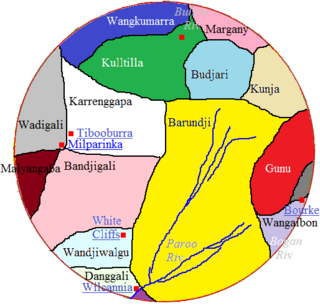The Bakanambia, also known as the Wanbara, are an Aboriginal group of Australia. Traditionally, the Bakanambia lived in the vicinity of Princess Charlotte Bay in the state of Queensland. One of the ethnonyms applied to them was Lama Lama, which is now used of a larger aggregation of remnants of several tribes.

Norman Barnett Tindale AO was an Australian anthropologist, archaeologist, entomologist and ethnologist.
The Wik peoples are an Indigenous Australian group of people from an extensive zone on western Cape York Peninsula in northern Queensland, speaking several different languages. They are from the coastal flood plains bounding the Gulf of Carpentaria lying between Pormpuraaw and Weipa, and inland the forested country drained by the Archer, Kendall and Holroyd rivers. The first ethnographic study of the Wik people was undertaken by the Queensland born anthropologist Ursula McConnel. Her fieldwork focused on groups gathered into the Archer River Mission at what is now known as Aurukun.
The Goeng or Gureng were an Aboriginal Australian people of the state of Queensland. They lived in the area of the area of present-day Gladstone.
The Mbewum were an indigenous Australian people of the Cape York Peninsula of northern Queensland. They were dispossessed and became extinct soon after colonization.
The Wikampama, also known as Wik Ompom, are an Aboriginal Australian people of Cape York Peninsula in northern Queensland.
The Mimungkum were an indigenous Australian people of Cape York Peninsula in northern Queensland.

The Karenggapa are an Aboriginal Australian people of New South Wales.
The Bidjara or Pitjara are an Aboriginal Australian people of eastern Queensland. They are to be distinguished from the Bidjara of southwestern Queensland and the Badjiri of southern Queensland.
The Kambuwal were an indigenous Australian people of the state of Queensland.
The Marrago were an Aboriginal Australian people of the state of the Cape York Peninsula in northern Queensland. They may have been a subgroup of the Mayi-Kutuna.
The Wiknatanja, also spelt Wik Ngathanya, are an Aboriginal Australian people, one of the Wik peoples of the Cape York Peninsula of northern Queensland.
The Wik Paach or Wikapatja are an Aboriginal Australian people of the Cape York Peninsula of northern Queensland.
The Wikatinda were an indigenous Australian people of the Cape York Peninsula of northern Queensland. They were one of the Wik peoples, but their language is unattested.
The Kulumali were an indigenous Australian people of the state of Queensland.
The Malintji were an indigenous Australian people of the state of Queensland.
The Marulta were an indigenous Australian people of the state of Queensland, Australia.
The Mitaka were an indigenous Australian people of the state of Queensland.
The Garaynbal, also written Karingbal, are an Aboriginal Australian people of the state of Queensland. They spoke a dialect of Biri called Garaynbal, now extinct.
The Ngulungbara were an Aboriginal Australian people or clan of Fraser Island in the state of Queensland, possibly of the Butchulla people.